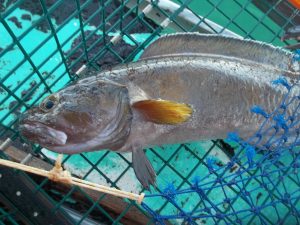Researchers, Lobstermen Seek Solutions to Fish’s Decline as a Team
 Few would have guessed cusk, an elusive fish that emerges from lobster traps with inside-out guts and bubbling skin, would become a focal point in the Gulf of Maine. The bottom dwellers have no commercial value; with their tough skin, they’re not even considered viable as bait. Still, a group of researchers, lobsterman and others have joined together to find a way to raise awareness of the cusk’s plight and return the potentially endangered species to its home on the rocky gulf floor.
Few would have guessed cusk, an elusive fish that emerges from lobster traps with inside-out guts and bubbling skin, would become a focal point in the Gulf of Maine. The bottom dwellers have no commercial value; with their tough skin, they’re not even considered viable as bait. Still, a group of researchers, lobsterman and others have joined together to find a way to raise awareness of the cusk’s plight and return the potentially endangered species to its home on the rocky gulf floor.
Over the last year, a cusk survival strategy has begun emerging. UMaine researchers and project partners discovered they could keep accidentally caught fish, or bycatch, alive by returning them to the back to the bottom in lobster traps. The research team’s strategy also involved hours of information sharing between stakeholder partners, including lobstermen, community groups and government officials at the local, state and federal levels.
The yearlong study, funded by the Senator George J. Mitchell Center for Sustainability Solutions, is part of the Emerging Opportunities – Foundations for Future Research grant program, focused on broadening the scope of the Mitchell Center’s community-based mission. These projects offer researchers a chance to engage new stakeholders in new places in new ways.
The issues facing researchers and stakeholders over the course of the project were multifold. In 2004, the U.S. Fish and Wildlife Service (FWS) named cusk a “species of concern” and began reviewing the fish for possible endangered status in 2007. It is not known how the lobster fishery could be impacted by such a listing. However, any Endangered Species Act listing results in the prohibition of harming the protected species and their habitat. This could create economic hardship for families that have lobstered in the bay for generations.
“This is a really good example of one of those ‘wicked’ sustainability problems,” said Christine Beitl, Assistant Professor of Anthropology and co-investigator on the project, “It’s one that requires some understanding that takes into account the social, the ecological and the economic considerations.”
“This is a complex problem, the kind that benefits from active engagement with stakeholders who hold diverse viewpoints and, thus, help create a more complete understanding of the picture,” Beitl said.
For more on cusk research, see this page
